
Once upon a time many of the world’s great cities maintained an active philatelic quartier.
Stamp shops tended to congregate in a specific part of town to cater for the needs of a hungry collector base who would depend on local dealers to serve their needs.
It is a business model that has been gradually disappearing over the past few decades. Renowned centres of philatelic activity such as Nassau Street in New York, The Strand in London and the Rue Drouot in Paris are but shadows of their former selves.
The rise of the internet, eBay, high city rents and a declining collector base have seen long established dealers retire or reinvent themselves in an online world.
Buenos Aires
However, unlike many cities in other countries, Buenos Aires is still managing to maintain an active ‘bricks and mortar’ concentration of dealers.
That’s not to say that activity is as robust as it was twenty years ago: there have been a number of closures. Even Stanley Gibbons opened their first international store here in the early part of the twentieth century although it closed its doors in the 1930’s.
But Argentina still boasts more walk-in stores than many other countries.
Dealers in Buenos Aires are concentrated within a few blocks of each other in the city centre, north of Avenida Corrientes. The galeria off Maipú 466 houses a number of established names.

Probably the best known is Guillermo Jalil, who, as well as a retail store, has a well established website and international auction business.
The business was established in 1978 and is managed day to day by the friendly team of Elizabeth, Anna and Walter with Guillermo visiting from his base at Bahía Blanca, seven hundred kilometres down the coast, on Friday afternoons.
Guillermo and José Luis Göttig (a dealer based in Santa Fe) jointly edit the recently released ‘GJ’ specialised catalogue of Argentinean stamps and it’s been selling encouragingly well (read the review). On a print run of four thousand, one thousand plus have already been sold: a good indicator of the strength of interest in Argentinean material.

The ‘GJ’ catalogue is a key reference work for most dealers that cater for Argentinean collectors. For the rest of the world, Yvert is by far the most popular catalogue with Scott trailing behind.
Quite why a French published catalogue should dominate is probably lost in the mists of time but Yvert’s presence is felt across much of South America and tends to be the main reference work for local collectors.

Deeper into the mall is the store of Filatelia Chiavello, a second-generation family business owned by Carlos Chiavello and actively supported by his wife and children. A crammed window display of classic Argentinean material is a foretaste of what lies inside.

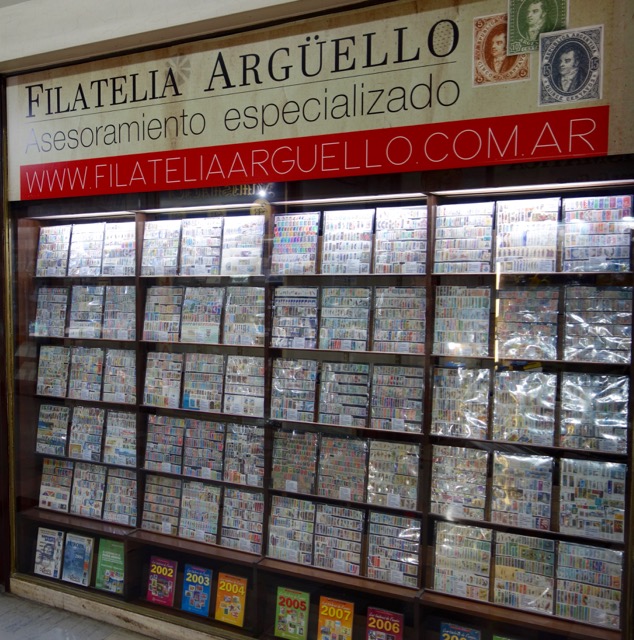
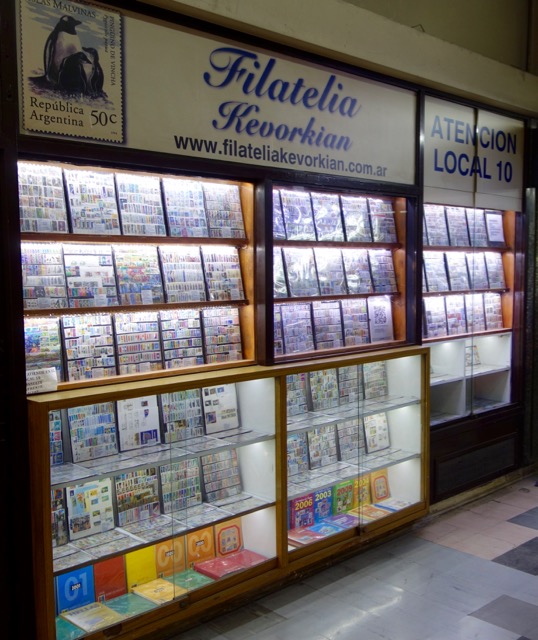
Two blocks west on Avenida Corrientes, the Galeria Porteña also contains a number of stamp dealers, together with those specialising in numismatics, bank notes and other collectibles. A little more ‘down at heel’ the mall has clearly seen better days, with dealers located amongst other, er, less salubrious establishments.
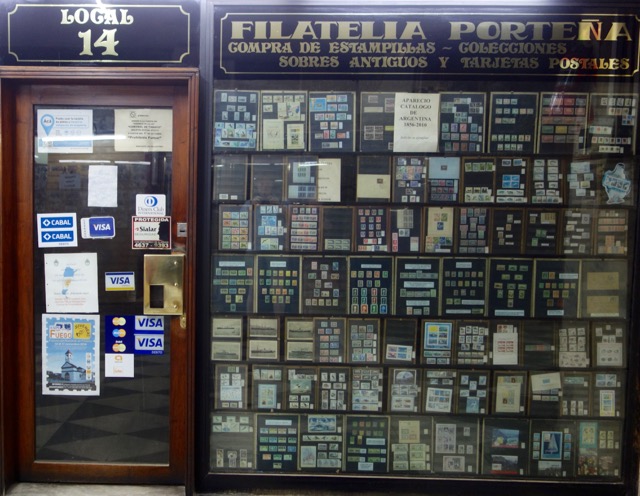
In the window of Filatelia Porteña I spotted a slowly fading full set of the 1933 Falklands issue, incongruously surrounded by modern penguin thematics and relatively inexpensive material. At a current Gibbon’s catalogue price of £4250 there’s a deal to be done by someone!
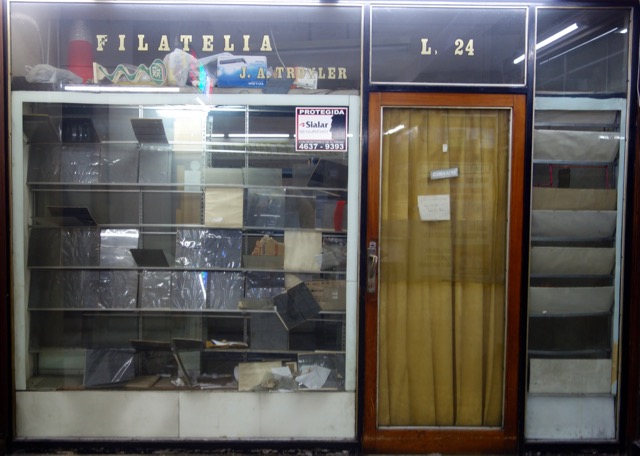
Empty shop fronts reflected the nature of the changing times mentioned at the start of this article. The end of an era for some but for others, the consolidation to fewer dealers may well bring additional business to those that evolve and adapt to the digital environment.
Standing alone on Viamonte, a couple of blocks down from the famous obelisk, is the Kurchan stamp shop. Run by the two sons of the founder, this Buenos Aires stalwart has been serving collectors for over forty years.
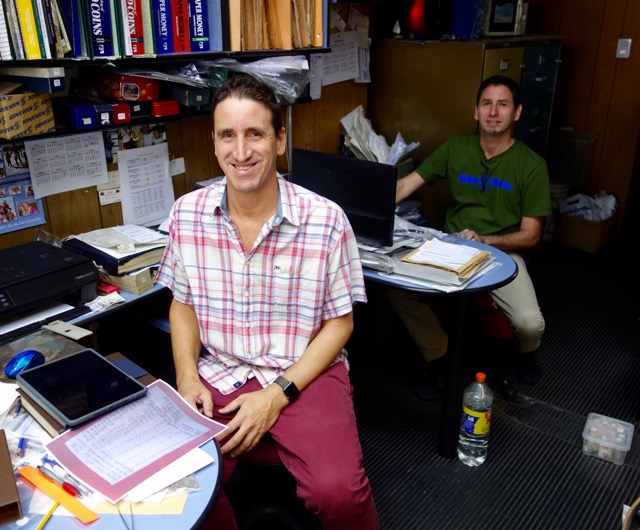
In the short half hour I was in the store two collectors entered, purchased and left. Perhaps not the footfall enjoyed in years gone by (and maybe purely coincidental) but good to see a decent level of activity on a weekday morning.
Córdoba
Seven hundred kilometres to the north west of Buenos Airies, Córdoba is Argentina’s second largest city. It still maintains three stamps shops although the merchandise isn’t entirely philatelic. Bank notes and coins jostle for shelf space and the selection of material is expectedly less comprehensive than in the capital.
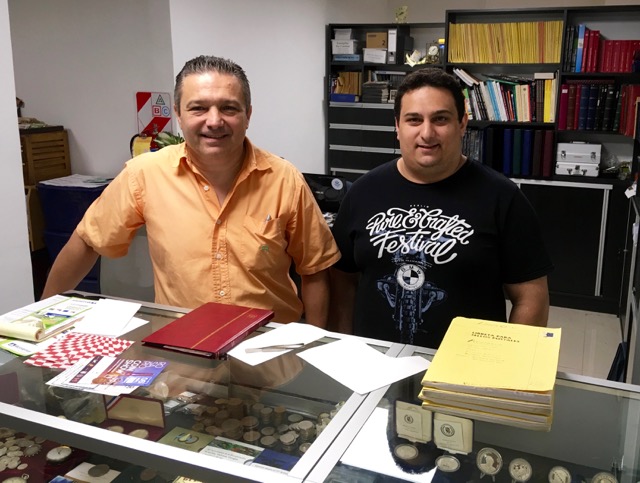
I stopped at Filacor (a portmanteau of philately and Córdoba) at the Galeria La Merced in the heart of the city. Established for nearly thirty years, philately seemed to be taking something of a back seat here: coins and bank notes are now the focus. Roberto and Roberto Jr. explained that numismatics were currently more popular.

Montevideo, Uruguay
Crossing the River Plate and into Uruguay, Montevideo still maintains a single stamp store…with a strong focus on the classics.
Estudio Filatélico Pegaso was named after the Uruguayan airmail issue of 1929-1943 and is run by Carlos Hernandez Rocha and Gabriel Martinez.
Carlos is well respected for his expertization and certification of early Uruguay whereas Gabriel maintains the store and runs regular local auctions every two to three months.
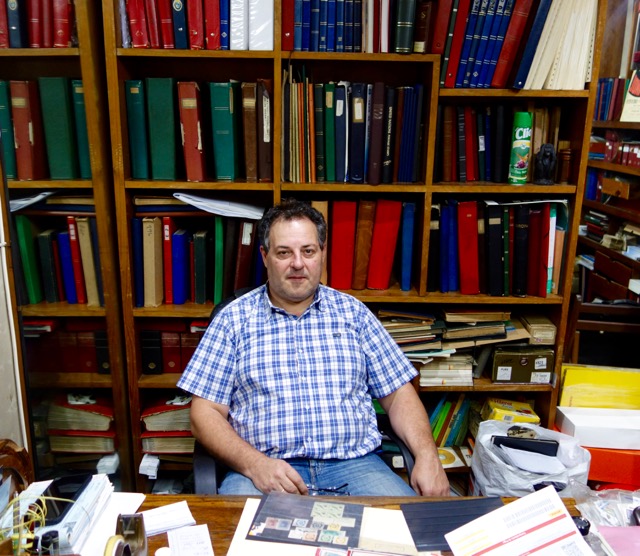
Again, Yvert is the dominant catalogue. Its numbering system is also adopted within the specialised Ciardi Uruguay catalogue.
Estudio Filatélico Pegaso probably serves around 120-150 local collectors: down from 300-odd from years ago but no different to what one might expect in other parts of the world. New blood comes from recent retirees rather than youngsters. Again, a trend replicated worldwide.
Supplementing Pegaso’s activity are three or four eBay collector/dealers specialising in Uruguayan material. Although Mercado Libre (the Latin American online platform, owned by eBay) is dominant in certain market categories, eBay is still the preferred marketplace when it comes to selling stamps.
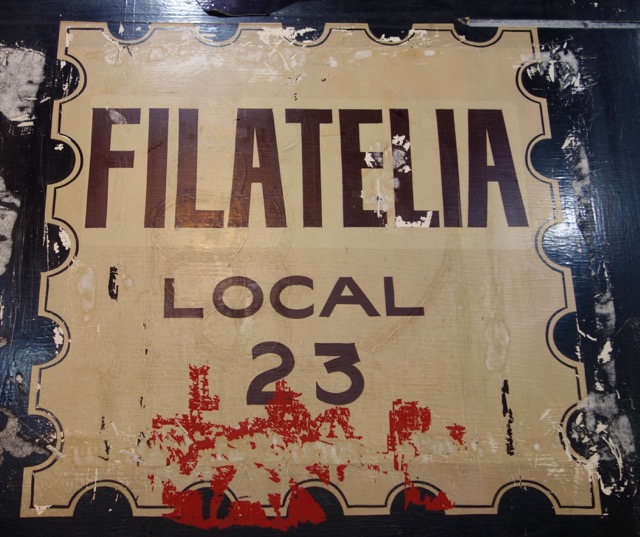
Whilst in Montevideo, I couldn’t leave without paying a visit to the Correos Central, the city’s main post office.
Although the purchase of stamps is now undertaken in another part of the building, the old wooden counters and hatches are preserved, along with a small museum. So many of the stamps residing in Uruguay collections around the world must have been sold across these counters in days gone by.
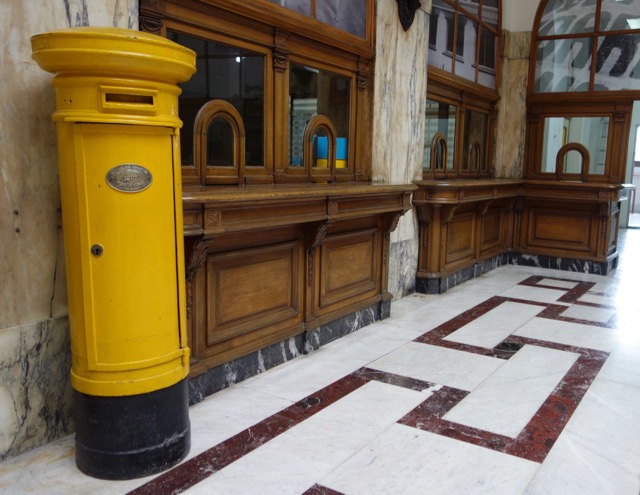
In most ways, the demographic trends and shift to online, mirror the experiences felt in other countries. But it is good to see that a number of bricks and mortar stores in this part of the world are still with us.
Long may it continue.

Hi – I am looking to purchase old tobacco cards issued in South America (especially Lima and Peru but not limited to that Country). Cards must have been issued before the year 1910. I am based in Australia and will be visiting Buenos Aires and Santiago in February next year